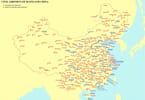(eTN) – Dr. Zahi Hawass, Secretary General of the Supreme Council of Antiquities (SCA) announced last week a Russian-American archaeological mission has unearthed a number of well-preserved Graeco-Roman mummies covered in cartons. They made the discovery during a routine excavation work at the Deir el-Banat necropolis in Fayoum.
Hawass added the mission uncovered three coffins decorated with religious texts from the Book of the Dead. One mummy in bad state of preservation was found in one of these coffins. Her face was covered in a gilded mask. Bracelets, jewelry, and forty textile fragments decorated with an anchor, crossed with some key signs, were also found.
Galina Belova, the director of the Russian mission, said some facial reconstruction will be done on the female mummy next season. She explained the restoration of ceramic and faience vessels excavated during previous seasons has been already completed.
Rather than the mummies, Fayoum may be known more for its religious history. Villages in Fayoum support previous findings about Roman persecution by Christians in Egypt. Archeological remains from this persecution are not well known but are on display. Coptic Christian crosses from this period can be found in caves in Fayoum, the same ones crosses visitors find in pharaonic tombs in Luxor, and the temple of Dendera near Qena. These locations probably served as hiding places for Christians during the Roman persecution.
The period between the year 200 and the council of Chalcedon (451) was a period of flourishing for the Coptic Orthodox Church. In spite of the Roman persecution of Christians the church continued to grow. The persecutions were most severe during the emperor Diocletian’s reign (284-311). The size of the Christian persecution in Egypt was probably larger than in other countries because of the size of the Christian community in Egypt. The Church knows several saints from those days such as Menas and Dimyana. The persecutions have made such a deep impression on the church that the Coptic Orthodox Church decided to start its era in the year 284. The year AD 2000 is therefore for the Copts, the year 1717 AM (anno martyrum).
Ironically, the world’s oldest churches and ruins of churches in Egypt which date back from the fourth century are no longer building their premises on this site – if not for connections. Today, one of the issues often raised is the difficulty to build churches in Fayoum. Father Dr. Rufa’il Samy of the village of Tamiya in Fayoum showed tremendous building activities in his village, changing a village church that was built in 1902 into a huge cathedral. The old church measured 14 by 16 meters, the new church 29 by 34 meters. The old church had a tower of 12 meters high. The new church has a tower of 36 meters high. The building activities are perfectly legal per presidential decree of 1994 that was obtained in only a few months time. There is no known opposition to the building from the Muslim population. The priest revealed a secret: building good relations with the local Muslim population and authorities.
There are villages and cities where Christians experience difficulties with building, renewing or repairing churches but we there are villages where such problems do not exist.
In Fayoum, new churches built, with the help of influential connections, and new mummies found may not put the village immediately on the tourism map of Egypt. However, few visitors who have gone tired of traditional excursions may want to see something different in a not-so-familiar rural spot.






















